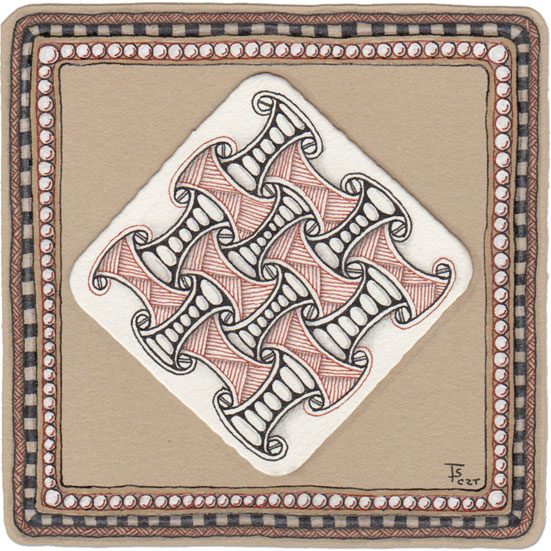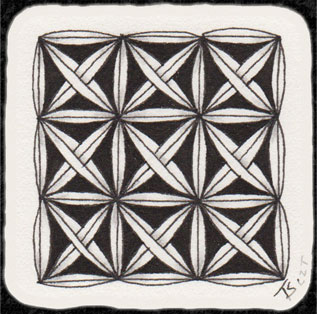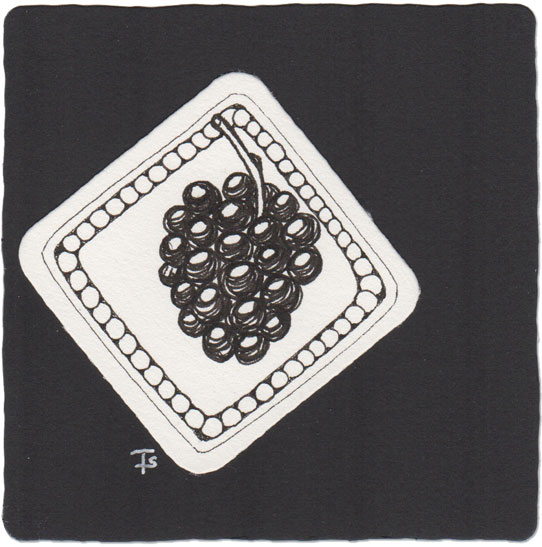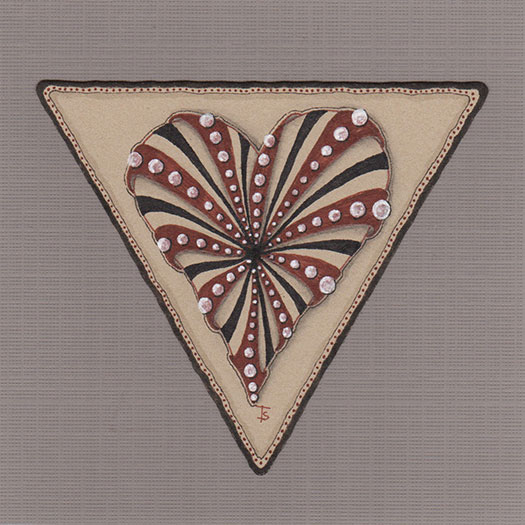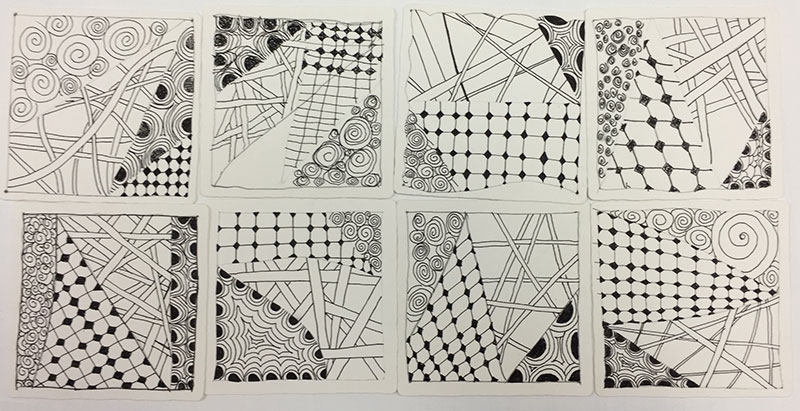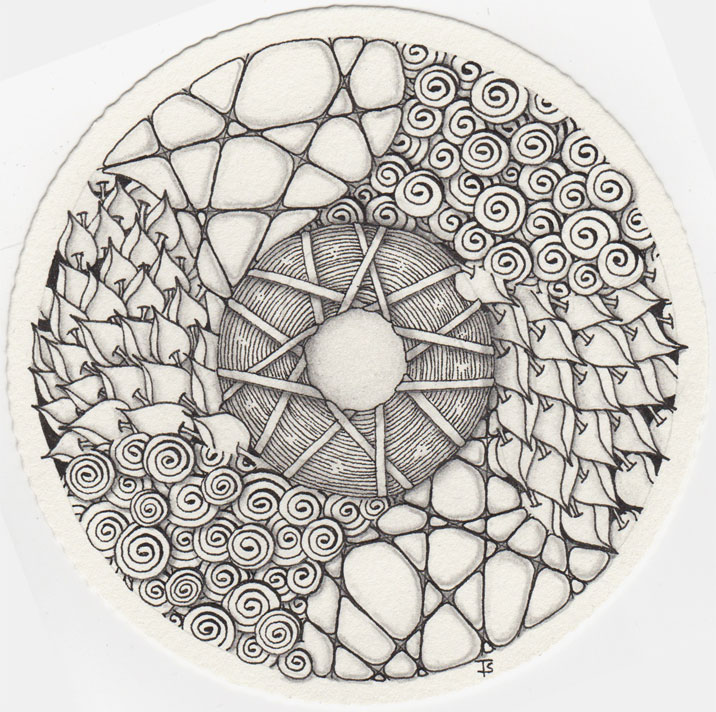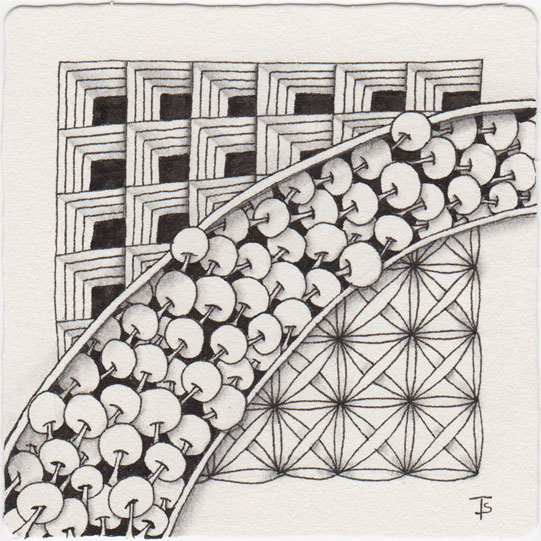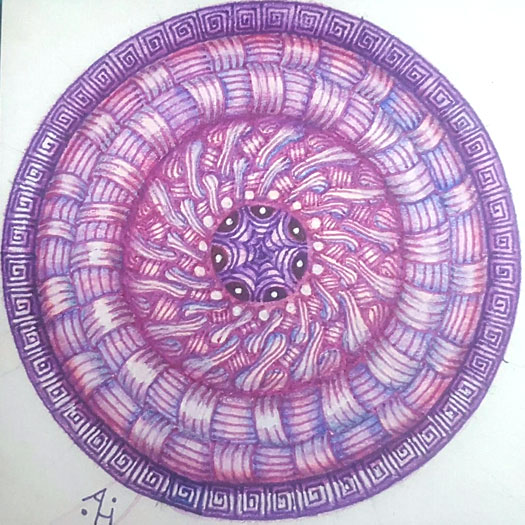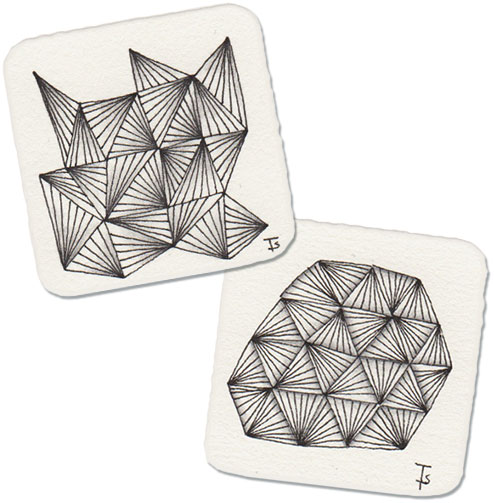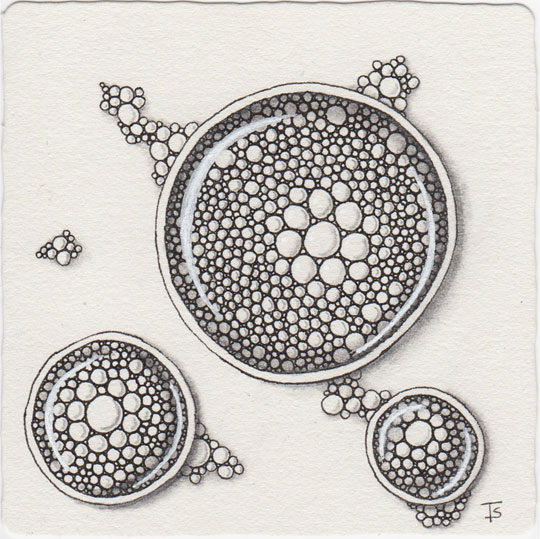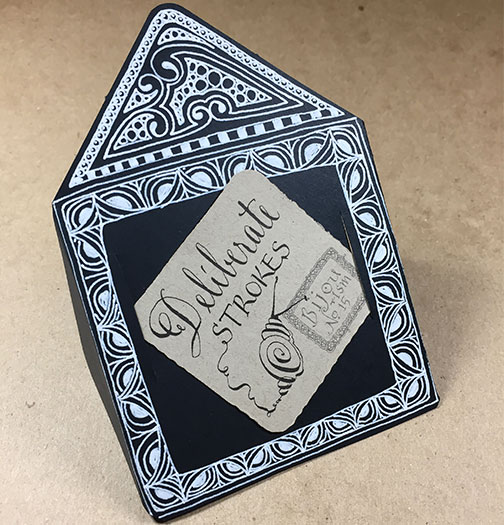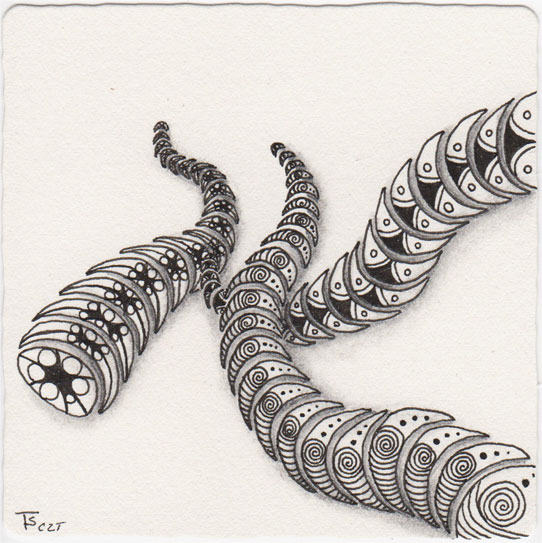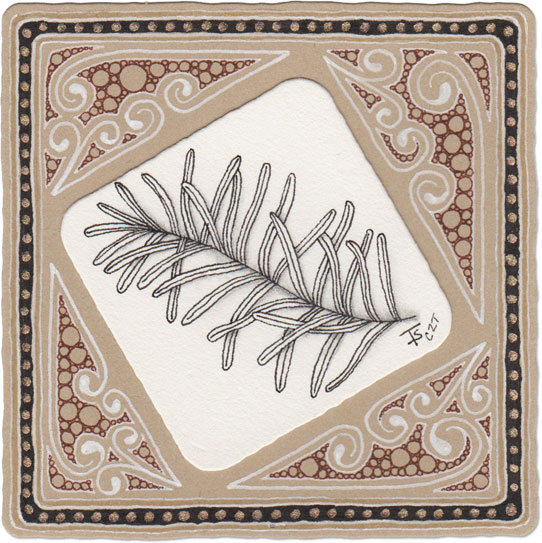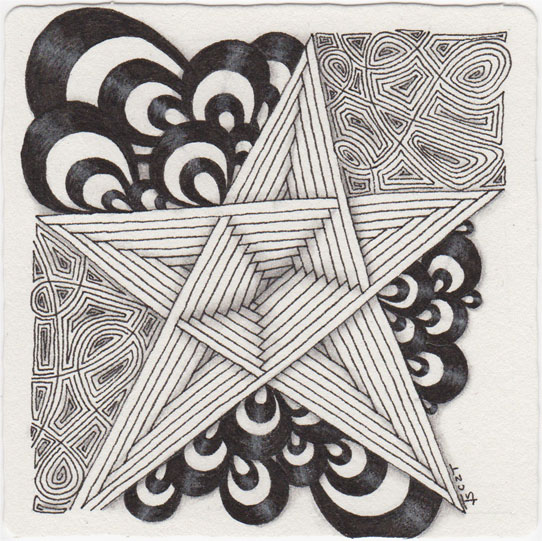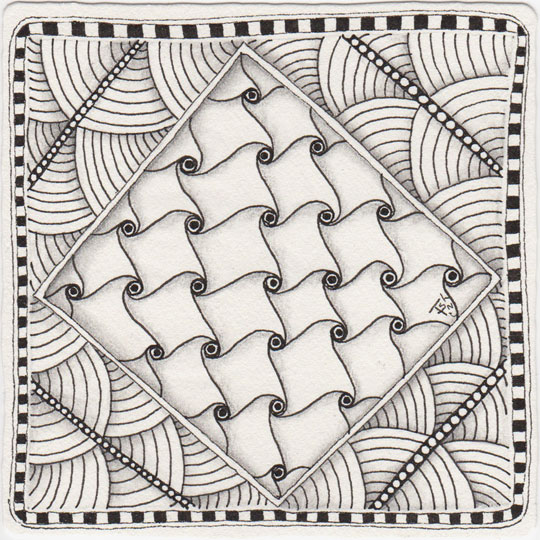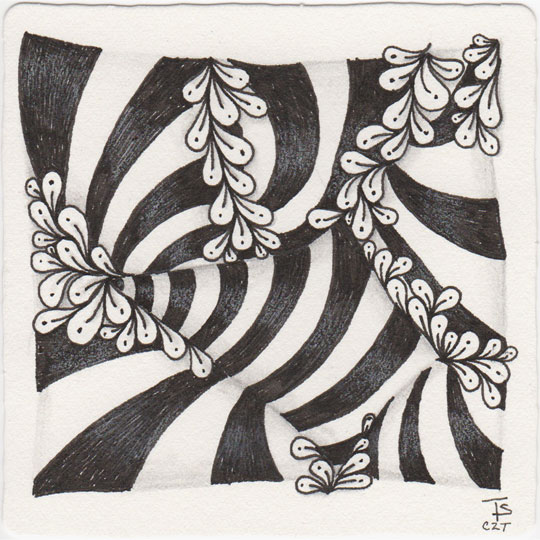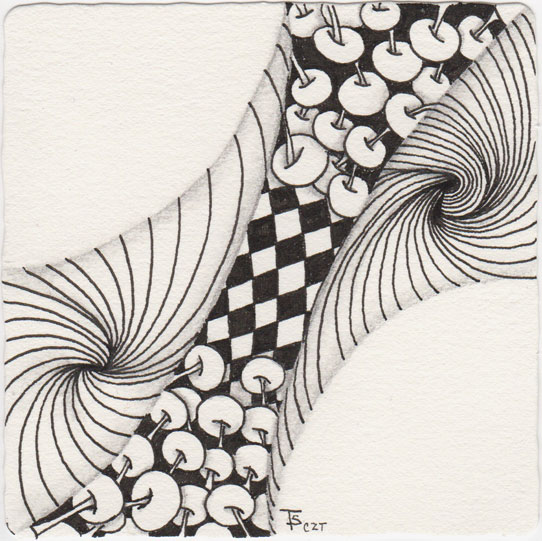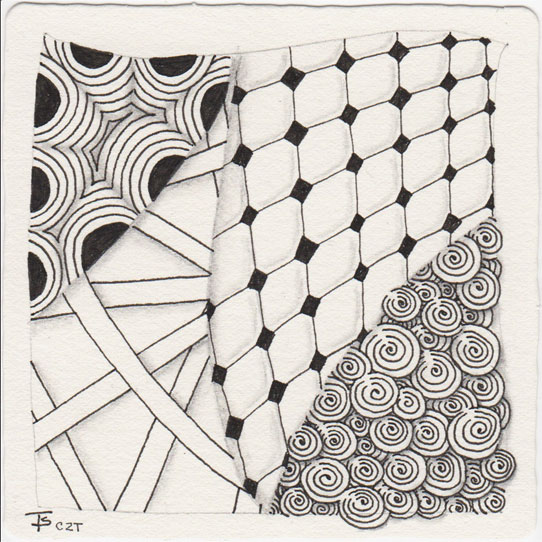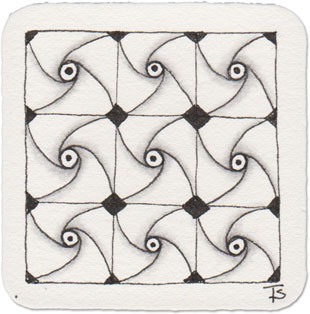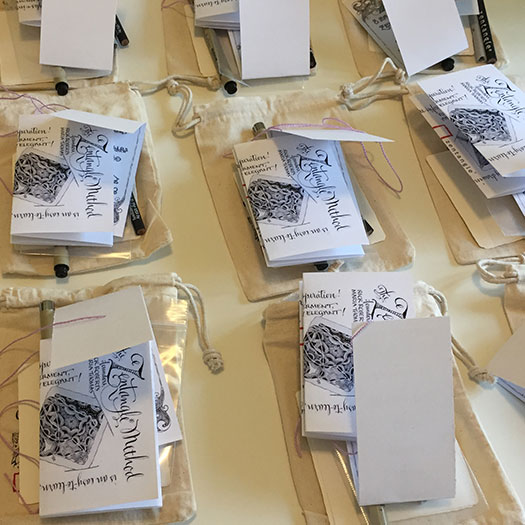All dressed up.
This little bijou is a remake of one I did at the CZT seminar. I decided to dress it up a bit by mounting it on a tan tile and adding a few frames. Huggins has become one of my favorite, meditative tangles!
Zentangle drawn on an Official Zentangle Bijou tile using a black and brown, Pigma Micron pens and white, Sakura Gelly Roll. Shading done with graphite pencil and Copic markers.
Tangleation.
Sometimes you just need a small change to create an interesting difference.
A Tangleation is a noticeable variation of an existing pattern. Here, the original tangle was Bales. In this version, it appears as if one rice shape is piercing the other where they cross.
Sometimes you just need to tangle a small thing and then move on with your day.
This is a Bijou tile, and there is just one tangle on it. Perhaps you are busy, and don’t think you have time to tangle. You don’t have to make a large tile with a complicated piece of art! You can make a small, simple wonder on a Bijou! They’re only 2-inches square, and still add a little Zen to you day!
No mistakes.
That’s right… There are no mistakes in Zentangle. Unexpected things DO happen, but they aren’t mistakes. They are opportunities to explore another direction. You don’t give up. You don’t throw away the work you’ve already done. Following a different fork in the road can take you to new vistas and allows you to discover new techniques. Some of the best tiles I’ve made come from unexpected twists and turns during the process. Here are some links to tiles that went off in directions that were unplanned.
This is another tile that I, unfortunately, left at Seminar. But I have to say that I actually like this version better! I normally put finished tiles in my scrapbook on a black background. But here, I decided to change it up a bit because I made the edge of the 3Z black. With it on a taupe background, I think it stands out better.
Zentangle drawn on an Official Zentangle 3Z tile using a black, sepia and brown, Pigma Micron pens and white Sakura Gelly Roll pen. Shading done with graphite pencil and Copic marker.
Monday, July 16, 2018 I taught the first and second Introduction to Zentangle classes at Good Gifts Healing Art Studio .
We had eight eager students in the first session. You can see their tiles above, before we did any shading on them.
The second session was smaller and more personalized, with two wonderful, attentive students. Below, I’ve added my tile to the mosaic to make it more impactful.
I had so much fun with everyone! It was really interesting to listen to each student’s story and find out what brought them to Zentangle and what they plan to do with.
I accidentally left 3 tiles behind at the CZT Seminar. While I’m sad about that… I decided to recreate them! This one is done on a Zendala tile, but it’s not perfectly symmetrical. Working in the round isn’t something that I do very often. But I was very surprised at how relaxing this was. I think not having to make everything match from side to side takes the stress out of this type of design.
River of berries.
Adding a bit of graphite, using a simple pencil and a tortillon, transforms tangles on a tile into a small piece of art and fills it with life. Don’t fear the pencil!
Zentangle drawn on an Official Zentangle tile using a black, Micron pen. Shading done with graphite pencil.
Tangles: Fife Flukes Poke Root
This beautiful Spundala was created by CZT Amanda Higbee! I am blown away that she used Pea-nuckle in the round. I don’t think that I’ve ever seen anyone do that before! It certainly never occurred to me to try it!
Zentangle drawn on Strathmore Vellum Bristol using a purple and pink, Sakura Pigma Micron pens. Shading done with watercolor pencils.
Tangles: Crescent Moon Emingle Keeko Pea-Nuckle
Difference.
These two little Bijou tiles both have the same tangle, Munchin. The first tile, in the upper left, was done by scattering dots on the tile and then drawing the tangle in the traditional way. I added shading at the convergence of the lines for each small triangle.
For the second tile, I started in the center of the tile with one triangle. Then, I added each new triangle, growing off of the existing ones. The shading in each triangle was added at the far edge, where all the lines ended and are spread out.
Tiny bubbles (tiny bubbles) In the wine (in the wine) Make me happy (make me happy) Make me feel fine (make me feel fine)
Leon Pober Sorry, I just couldn’t resist!
Zentangle drawn on an Official Zentangle Tile using a black, Micron pen. Shading done with graphite pencil. Highlights created with white colored pencil and white acrylic paint pen.
We have learned to appreciate and focus on each thing, one stroke at a time.
I love this frame made from an Apprentice tile. I also really love the bijouism that was added to it by our guides! You can get your own collection of 24 bijouisms by following the link. The little tin actually contains two of each… one for you to keep and one to give away!
Zentangle drawn on a black Original Zentangle Apprentice tile using a white Sakura Gelly Roll.
What are these creatures we found hiding under the leaves? Each one is different, bearing fragmented patterns creating their own interpretation? It is our third day along this path. We’ve grown bolder, looking here and there and finding new things or changing the old.
Zentangle drawn on an Official Zentangle tile using a black, Micron pen. Shading done with graphite pencil.
Tangles: Articulated Molygon
Remembrance.
As we walk on this path, I am reminded to spend time with others I’m walking here with. The time will go so fast and we will, literally, be scattered to all the corners of the earth. But we will remember each other, and this special time here.
This beautiful, rosemary stem is drawn using the tangle Verdigogh. Rosemary is for rememberance. I wanted to add something to it, but I couldn’t decide what. Then I realized the Renaissance frame would be perfect. So this frame was drawn on July 3, 2018 and I set the tile from the CZT 30 Seminar in the center of it. I wanted to honor, treasure and remember my time there.
As our raft came to an island in the sea, we looked up and saw how close the stars appeared, twinkling through the openings in the tops of the giant plants. Looking down, I saw the small eddies and swirls left in the sand by the waves and small creatures. I think I’ll explore this island further.
Zentangle drawn on an Official Zentangle tile using a black, Pigma Micron pen. Shading done with graphite pencil. Highlights done with white colored pencil.
We’ve traded yesterday's spacial vortex for an ocean raft which we’re riding across the waves. So many ways to travel on this journey! I wonder what we will discover on the other side?
Zentangle drawn on an Official Zentangle Tile using a black, Micron pen. Shading done with graphite pencil.
Tangles: Cadent Knight's Bridge Shattuck
I think we’ve found a special dimension that warps time and space. As we go along for the ride, the plants along the side of the path start poking through here and there to remind us of where we’re going.
Zentangle drawn on an Official Zentangle tile using a black, Micron pen. Shading done with graphite pencil. Highlights done with white colored pencil.
Tangles: Flux Striping
The second day on our path we’re walking fast… faster than I am used to. I feel like I’m running to keep up with everyone else. Kind of out of breath and unable to slip into a rhythm.
This is our second tile. I’m so excited to see the mosaic we create together!
Zentangle drawn on an Official Zentangle tile using a black, Micron PN pen. Shading done with graphite pencil.
We all came to this particular path from different directions: locations, desires, experiences, expectations, dreams…
Now, we will travel together for a while. Each doing the same thing, but each doing it their own way.
This is our first step on this journey.
My first tile from the CZT30 seminar!
Zentangle drawn on an Official Zentangle tile using a black, Micron pen. Shading done with graphite pencil.
Tangles: Crescent Moon Florz Hollibaugh Printemps
This little Bijou tile is going into my tangle index book. It shows a hybrid between Well and Florz. I like the way, when it is shaded, it looks like it is woven!
Zentangle drawn on an Official Zentangle Bijou tile using a black, Micron pen. Shading done with graphite pencil.
Tangles: florz well fwell
Unfortunately, no time for tangling yesterday. I spent the day putting together kits for teaching classes! I’m really looking forward to sharing Zentangle with new students.
Even after 8 years, teaching still excites me. I love watching the students discover that they CAN tangle and create beautiful works of art, even if they thought they couldn’t. It always surprises and delights.
